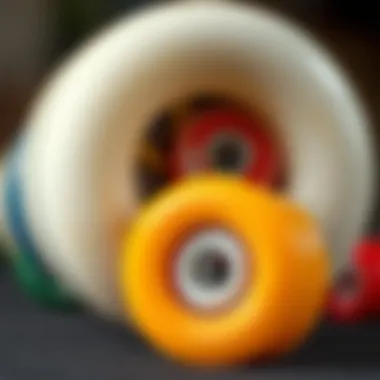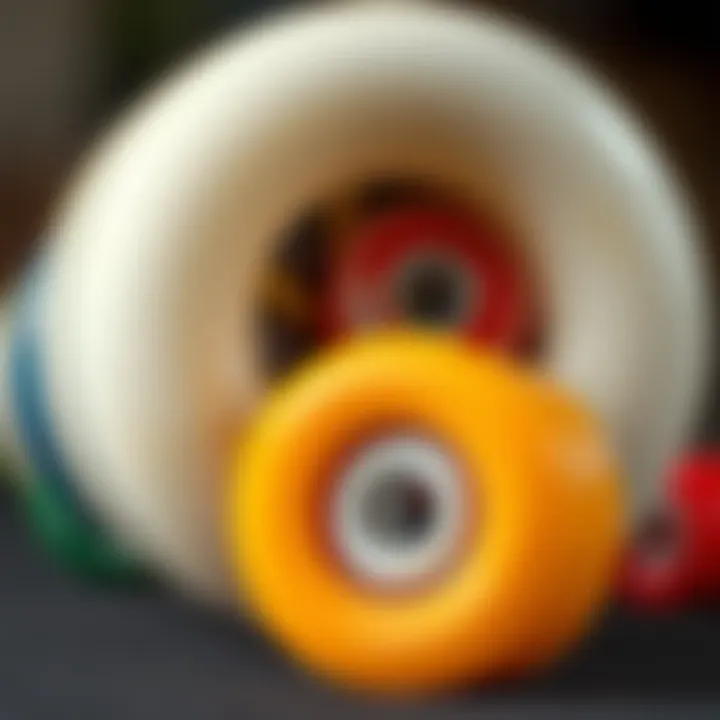Choosing the Perfect Skateboard: A Complete Guide


Intro
Skateboarding is more than just a sport; it's a lifestyle that resonates with thrill-seekers and creatives alike. As a skateboarder—whether you're just rolling onto the scene or catching some serious air—understanding how to select the right skateboard becomes crucial. It's not merely about aesthetics or brand loyalty. It’s about functionality, safety, and most importantly, enjoyment.
This guide attempts to untangle the intricacies involved in choosing the right skateboard. It aims to shed light on various aspects of skateboards, from their core components to different styles and sizes. We’ll also touch on essential gear and safety equipment, which can make all the difference between a ride you’ll cherish and one that might leave you bruised.
By the end of this exploration, you should have a clearer understanding of how to approach your skateboard selection. This information will empower enthusiasts, parents considering options for their kids, and retailers looking to guide customers, ensuring everyone has the right pieces of gear for the journey ahead.
Skateboarding Techniques
Mastering the Basics
Every journey begins with a single push. When it comes to skateboarding, that proverbial push is about getting comfortable on the board. Learning the basics lays the groundwork—balance, stance, and control are essential elements you can't overlook. Most newcomers start with learning how to ride, which means practicing rolling along flat surfaces.
You might discover the joy of pushing off with your foot while maintaining balance, and navigating straight ahead. Once you're comfortable, try experimenting with turning. Carving left and right not only aids in maneuvering but enhances overall coordination and confidence—it’s an art form in itself.
Advanced Tricks and Stunts
After you handle the basics, the excitement kicks up a notch. Moving beyond simple riding, advanced tricks such as the ollie and kickflip can be quite rewarding. Perform these tricks not only serves to heighten your skills but sparks creativity; exploring your capabilities can lead to a newfound love for skateboarding.
As you delve deeper, you might want to engage with the skateboarding community. Platforms like Reddit often have forums where you can share experiences or seek advice on trick formation. Mastering tricks, however, requires patience and practice. Remember, everyone starts somewhere; the path of learning can be frustrating but also immensely fulfilling.
Gear and Equipment
Skateboard Types and Features
Different skating styles demand different skateboards. Broadly speaking, there are several types to choose from: street boards, cruisers, and longboards, to name a few. Street boards, which are typically smaller and feature a concave shape, are perfect for tricks and street riding. Meanwhile, cruisers offer a more laid-back experience, ideal for errands and leisurely rides.
Longboards bring their own charm and stability, making them suitable for downhill rides and commuting. When selecting your skateboard, considering the features—like the deck’s width, wheel hardness, and truck type—is vital. Each component can significantly influence your experience.
Essential Safety Gear
A wise saying goes, "Better safe than sorry." Investing in safety gear is essential for both novice and experienced riders. Helmets, knee pads, elbow pads, and wrist guards should be non-negotiable components of your skateboard lifestyle. They not only provide protection against falls but create a sense of confidence as you push your boundaries.
- Helmets: Crucial for head protection during falls.
- Wrist guards: Help prevent wrist injuries.
- Knee & elbow pads: Protect joints while performing tricks.
In short, as you embark on your skateboarding adventure, remember that safety comes first. Not every ride will be flawless, and bumps will happen; minimizing injury through gear can keep your skateboarding experience enjoyable.
"Skateboarding is not about the tricks or the status; it's bout freedom—freedom to express yourself on four wheels."
With this groundwork laid, the next step is narrowing your focus on finding the right skateboard that speaks to your needs and aspirations. For further reading on skateboarding safety, you might check out resources from sources like Healthline or SkateSA.
Navigating the world of skateboards can feel overwhelming at first. However, the effort you put into understanding the components and styles will equip you far better than any flashy advertisement. The more informed you are, the more rewarding your skateboarding experience will be.
Understanding Skateboards
The world of skateboarding is as diverse as it is exciting. Understanding skateboards is the bedrock of making a well-informed choice when selecting your ride. With the right knowledge, one can avoid the common pitfalls that many newcomers face while venturing into this thrilling activity. From knowing the essential parts of a skateboard to grasping the different types available, diving into each aspect arms you with better decision-making power. More importantly, it enhances your overall riding experience, whether you're cruising down the street, hitting the skate park, or carving on a longboard.
The Basics of a Skateboard
Every skateboard is fundamentally a mode of transport. But it’s not just about getting from point A to B; it’s about how you feel doing it. The basic structure includes a flat board, wheels, trucks that connect the wheels to the board, and bearings that allow the wheels to rotate. These components come together to create a vehicle that is not only functional but offers a unique experience based on the rider's preferences. Knowing these basics sets the stage for understanding why selecting specific parts is crucial for performance and comfort.
Key Components Explained
Deck
The deck is like the stage for a skateboarder. It’s the part where all the action happens. Usually made from maple or other hardwoods, decks establish the board's weight and rigidity. The width of the deck influences everything from stability to how easily you can maneuver. For instance, a wider deck provides more stability, making it ideal for beginners. On the flip side, a narrower deck offers agility, suiting more advanced skaters who need quick responsiveness. The unique feature of a deck is its concave shape that helps in providing better foot placement and control. However, too much concave can affect comfort for some riders.
Wheels
Wheels are another essential aspect, acting as the contact point between the skateboard and the ground. Made from polyurethane, some wheels are softer for grip and smooth rides, while others are harder for tricks and slides. Wheel size also affects ride quality; larger wheels roll over obstacles more easily, which is great for cruising, but they sacrifice maneuverability. An interesting feature is the durometer rating, which measures wheel hardness. Softer wheels for rough terrains can absorb shock, while harder wheels give you more speed on smooth surfaces.
Trucks
Trucks are the metal mechanisms that hold the wheels in place and allow for turning. They come in various widths to match the deck, making choosing the right truck crucial. A lighter truck means less weight overall, which is great for doing tricks. A key characteristic of trucks is their ability to be adjusted for tighter turns or a looser feel, impacting riding style. However, if the trucks are too loose, balance can become a challenge, especially for beginners.
Bearings
Bearings are like the unsung heroes of skateboarding. They allow the wheels to spin effortlessly, which is vital for speed and smoothness. High-quality bearings reduce friction, enhancing overall performance. The ABEC rating system usually indicates their quality; higher ratings mean better precision and speed. Nonetheless, some argue that beyond a certain level, the difference is marginal and not worth the extra cost for casual riders.
Types of Skateboards
Understanding the types of skateboards can significantly impact your choice, as different boards cater to different riding styles.
Longboards
Longboards, as the name suggests, are longer than standard skateboards. They are designed for cruising and downhill riding, which is beneficial for those who enjoy a smooth, stable ride. The longer wheelbase provides more stability, making it easier to balance at higher speeds. One unique feature of longboards is the drop-through design, which lowers the center of gravity, enhancing control. However, their size can be cumbersome for tricks.


Street Skateboards
Street skateboards are shorter and more versatile, catering to those who thrive in urban environments. The size and shape enable easier tricks and jumps, making them popular among skaters who frequent parks or streets. A defining aspect is the concave shape of their decks, allowing for better foot placement for tricks. Despite the advantages, some may find them less stable for cruising compared to longboards.
Freestyle Boards
Freestyle boards are a niche within skateboarding, focusing on tricks and creative maneuvers on flat terrain. They are usually symmetrical, giving riders an equal footing for various maneuvers. This style promotes innovation in tricks, making it appealing for adventurous riders. The trade-off with freestyles is that they often sacrifice speed and stability.
Ramp Skateboards
Ramp skateboards are specifically designed for skate parks and vert ramps. They are often wider for improved stability during aerial tricks. One distinctive feature is their reinforced construction to handle hard impacts. While fun in a park, they can be less practical for street use due to their design optimizations.
Ultimately, understanding skateboards and their components allows riders to tailor their choice to their individual needs, whether they are just starting out or are seasoned pros. Each skateboard type offers unique perks and drawbacks, and being informed can make all the difference in the riding experience.
Determining Skill Level
Selecting the right skateboard fundamentally hinges on the skill level of the rider. Understanding where one stands in their skateboarding journey is crucial; it not only influences the type and features of the skateboard but also enhances the overall riding experience. When a skateboarder chooses a board tailored to their skill level, it plays a significant role in safety, comfort, and performance. Whether someone is just starting, somewhere in between, or a seasoned pro, aligning the deck’s properties to their abilities can lead to greater confidence and mastery on the board. By addressing the needs of various skill levels, this section demystifies the process of skateboard selection.
Beginners
Recommended Features
For beginners, the skateboard should ideally have certain features that make learning how to skate smoother. A wider deck aids in stability, which is essential for beginners, allowing for better balance during those initial rides. Additionally, softer wheels can absorb shocks better, providing a more comfortable ride over rough terrain—something new riders often encounter.
A popular choice is the element of grip tape. Good grip tape can make a world of difference for newcomers. It ensures that their feet stick to the board, reducing the chance of slipping off while learning basic tricks and maneuvers. However, it’s essential not to go overboard with features; simplicity often trumps complexity for beginners.
Size Considerations
Sizing is another pivotal aspect that cannot be overlooked. A skateboard’s deck size should be proportional to the skater’s foot size; typically, a wider deck offers more surface area for beginners. For instance, a standard deck width of 7.5 to 8 inches is often ideal for those just starting.
The unique element here is the length of the deck. Longer decks can offer heightened control but can also feel unwieldy for smaller beginners. On the flip side, shorter decks can be easier to maneuver but may sacrifice some stability. It’s crucial to find the sweet spot that offers both comfort and usability as the skater starts their adventure.
Intermediate Skaters
Adjusting to Advanced Gear
As skaters progress, the transition to more advanced gear can feel daunting yet exhilarating. Intermediate skaters often need boards that facilitate trick execution and provide reliability.
A notable characteristic of advanced gear is improved wheel hardness, which is essential for tricks requiring speed and agility. Choosing wheels that are firmer can allow skaters to perform slides without the hassle of rolling too slowly or getting bogged down by softer wheels on smoother surfaces. However, with harder wheels, skaters should also be aware that they may feel more vibrations on rough terrain.
Performance Needs
At this stage, performance needs also evolve. Skaters must consider what they want to achieve with their board—be it street skating, park riding, or a bit of both. A midsized deck, often around 8 to 8.5 inches, can be ideal for these purposes.
The deck’s material composition is vital in determining performance. A composite deck can handle wear and tear better than traditional materials, allowing the skater to push their limits. However, this often comes at a higher price, posing a dilemma where performance is weighed against budget constraints.
Advanced Skaters
Customization Options
Advanced skaters frequently delve into customization. This stage is when personal preference truly takes the reigns in skateboard selection. Each skater has distinct tastes regarding aesthetics and performance.
Customization can include selecting specific truck sizes, wheel varieties, and deck designs that resonate with their style. A characteristic feature here is the ability to finely tune performance, which is especially valuable for those specializing in particular skate styles. However, with greater customization comes a steeper learning curve, as skaters must navigate a myriad of options to find the perfect fit.
Materials and Durability
Material selection becomes increasingly critical for advanced riders. Many skaters turn to materials like carbon fiber or high-grade maple to ensure that their boards can withstand intensive tricks and rough landings.
Durability should be a key characteristic as well; a board with a reputation for longevity promotes confidence in performance, minimizing unexpected failures during a trick. The downside? Sturdier materials can often create a heavier board, which may influence how the skater performs specific tricks.
With the right gear, from beginners to advanced skaters, there's no limit to what one can achieve on their skateboard. Whether through choosing the right features, understanding sizing, or exploring customization options, every decision can lead to an enriched skateboarding experience.
Navigating the Market
When it comes to choosing a skateboard, understanding how to navigate the market can make all the difference. With so many brands and models, it’s easy to feel overwhelmed. Knowing what to look for helps buyers make an informed decision, ultimately leading to more satisfying purchases. Successful shopping marries knowledge with intuition, creating a balance between individual preference and broader trends in skateboarding.
Popular Brands
Brand Reputation
Brand reputation in skateboarding can be likened to a badge of honor. A strong reputation often indicates reliability, quality, and a history of skateboard manufacturing. Brands such as Element and Santa Cruz have stood the test of time. Their well-established names carry with them trust from both beginners and seasoned skaters alike. A reputable brand typically has favorable reviews and feedback from users over the years. This characteristic gives it an edge because it often leads to increased resale value, as skaters recognize the quality in these brands and are willing to pay a little extra. It also means buyers can expect parts and accessories readily available, making repairs easier.
Product Range
A varied product range is vital in meeting the unique needs and preferences of skaters. Companies like Powell Peralta or Globe offer skateboards that cater to different skating styles. From longboards to street decks, the extensive selection means there's something for everyone. This aspect makes these brands favorable, as it allows skaters to not only find the right board for their style but also encourages growth and adaptation as their skills progress. However, it’s important to note that a broad product range can sometimes lead to decision fatigue if potential buyers aren’t clear on their requirements. Still, the variety makes exploring new options exciting and beneficial.
New Trends


Emerging Designs
Emerging designs in skateboarding often reflect shifts in consumer preferences and advancements in technology. Brands nowadays are experimenting with shapes and materials, creating skateboards that not only perform better but also look unique. For instance, the rise of the asymmetrical skateboard design allows for enhanced tricks and a different aesthetic appeal. Such innovations attract attention and provoke interest, making skating more than just a sport; it’s also becoming an art form. These novel designs often lead to conversations and enthusiasm about skateboarding, which is vital for community engagement.
Eco-Friendly Options
Eco-friendly options have gained traction in the skateboarding world. As awareness of environmental issues grows, many skateboard brands are looking to reduce their carbon footprint. Skateboards made from sustainable materials, like bamboo or recycled plastics, are becoming more common. This commitment to sustainability not only attracts environmentally conscious consumers but also portrays the skateboarding community as progressive and responsible. However, while these options may vary in price, sometimes they lean toward the higher end due to sustainable sourcing and manufacturing practices.
Where to Buy
Local Shops
Local shops hold a charm that online retailers can’t replicate. Walking into a shop allows you to see, touch, and sometimes test boards before buying. Local skateboard shops often carry unique, limited-edition products that you won’t find elsewhere, and there’s value in supporting small businesses. Staff are usually knowledgeable and passionate about skateboarding, providing insights that you won't gather from product descriptions online. The downside might be slightly higher prices compared to larger chains that offer discounts; however, the service and expertise you receive can be worth it.
Online Retailers
Online retailers have transformed how we shop for skateboards. Websites like Amazon or Skate Warehouse provide a wide array of choices and often feature customer reviews that can guide decision-making. One of the key advantages of online shopping is that prices are frequently more competitive than brick-and-mortar stores, and it’s easier to compare multiple models side by side. However, the lack of a physical experience can be a downfall; you can't see or feel the board, making it essential to rely on detailed descriptions and ratings. Ensure you are buying from reputable websites that have a solid return policy, just in case it’s not the perfect fit once it arrives.
"Finding the right skateboard is about more than just the board itself; it’s delving into the community, understanding trends, and figuring out what fits your style."
In summary, navigating the market not only involves knowing where to look and who to trust, but also understanding the broader trends shaping the skateboarding landscape. By appreciating the significance of brand reputation, current innovations, and buying platforms, consumers can steer themselves toward a skateboard that truly fits their needs.
Evaluating Quality
When it comes to buying a skateboard, understanding quality is non-negotiable. Simply put, the right skateboard not only enhances your riding experience but also ensures safety and longevity. Evaluating quality involves looking at materials, construction, and how the board performs on the street or in the park. Factors such as durability, construction precision, and material choice play a starring role here. A well-built skateboard can withstand the rigors of daily use, which is particularly important for those who push their equipment to the limits.
Material Considerations
Maple vs. Bamboo
Maple and bamboo often come up in discussions about skateboard materials. Maple, known for its strength and sturdiness, is the traditional choice for many skateboarders. Featuring a dense structure, maple decks can handle heavy impacts and are less likely to snap under pressure. This is especially appealing to street and park skaters who perform tricks that stress the board.
On the other hand, bamboo boards are gaining popularity due to their lightweight characteristics and natural flex. Bamboo is not only lighter than maple but also has a unique capability for absorbing shock, making it a delightful option for cruisers. However, some argue that bamboo may not have the same long-lasting durability as maple when it comes to heavy use. Thus, if you seek versatility and airflow beneath your feet, bamboo is a fine choice; yet, if you lean towards rugged reliability, maple might be your go-to.
Plastic Alternatives
Plastic alternatives for skateboards are also becoming more mainstream. They carry a few unique characteristics worth mentioning, primarily their resistance to water and harsh weather conditions. Unlike wood, which can warp and degrade, plastic boards often maintain their shape regardless of exposure to the elements. This makes them an appealing option for younger or beginner skaters, who might not yet have the precision to handle a more rigid board.
That said, the trade-off is in performance. Plastic decks can feel less stable at high speeds or during tricks, leading some skaters to prefer wood. Yet as a choice for casual cruising, plastic does serve beginners well, with the added bonus that they're often more affordable.
Construction Quality
Pressing Techniques
The methods used in pressing skateboard decks greatly influence their final quality. A common technique is the single-press process, which creates a well-defined shape but might not allow for optimal strength. Alternatively, more advanced pressing techniques employ a multi-press method, which layers wooden sheets together under high pressure for better stability and performance.
Some skateboard brands pride themselves on using the best pressing techniques, leading to decks that are not only visually appealing but also more resilient against everyday wear. These techniques can ensure a skateboard maintains its form over time, preventing the influence of warping that can easily ruin less-quality boards.
Layer Count
The layer count in a skateboard deck refers to how many thin sheets of material are bonded together to form the board. For instance, a typical maple skateboard might have 7 layers stacked together. Generally, more layers equal greater strength and sound performance. Think of it this way: a higher layer count translates to greater flexibility while retaining durability during tricks.
While a 5-layer board might work for beginners, skaters looking for high-impact performance may want to reach for boards with 7 or more layers. The trade-off to consider, however, is the weight; more layers could make the board heftier, impacting tricks requiring light-footed finesse.
Testing Performance
Flexibility Tests
Flexibility plays a significant role in how a skateboard performs. Certain skaters may prefer a stiffer board that allows for precise control during tricks, while others might opt for a flexible deck that provides better shock absorption on rough terrains. Flexibility tests involve bending the board in various ways to assess how it reacts.
Determining how well a board bends and springs back can give you insight into its performance during rides and tricks. Boards that flex too much could end up feeling wobbly, whereas those with too little flex could fail to offer adaptability on bumps and grinds.
Grip and Control
Finally, one cannot underestimate the importance of grip and control. A skateboard inherently requires a good grip to prevent slipping while executing tricks or cruising. Materials used for the grip tape can vary; some offer superior adhesion while others may wear out quickly.
Testing a skateboard's grip involves assessing how well you can maintain control during different maneuvers. This characteristic is key for all skill levels. A well-gripped deck can make the difference between executing that game-changing trick and hitting the pavement hard. Choosing a skateboard with reliable grip not only enhances performance but also maximizes your safety on the board.
Understanding Pricing
Selecting the right skateboard isn't just about understanding the components and getting the type that matches your skill level; pricing plays a critical role in the decision-making process. A well-priced skateboard can make all the difference between misplacing investment or discovering a great ride. Factors such as quality, features, brand and the market you're purchasing from all directly influence the price. Most importantly, by grasping pricing dynamics, buyers can find a board that suits their needs without breaking the bank or compromising quality.
Budget-Friendly Options
Best Brands Under a Budget
Budget options often get a bad rap, as they are perceived to lack quality. However, several brands have carved a niche for themselves in this domain. Brands like Element and Santa Cruz manage to provide decent boards at a wallet-friendly price. The key characteristic here is affordability without sacrificing performance. Some of these brands might have a limited set of features compared to pricier models, but they ensure a solid build that’s great for beginners or casual riders.


For instance, Element’s boards come with high-quality decks made from maple, ensuring durability and good performance. You'll find them weighing less on the pocket without weighing you down while skating. Just remember, while these boards provide great value, some might not have advanced features like customizable graphics or premium wheels that higher-end brands offer.
Sales and Discounts
Everyone loves a good sale, and when it comes to skateboards, sales and discounts can significantly aid in getting a quality board at a great price. Retailers often clear seasonal stock to make room for new arrivals, which leads to some attractive discounts. Events like Black Friday or Back to School promotions can yield especially good prices on various models. An important point to note is that during these sales, one must be cautious; tempting prices can sometimes relate to older stock.
While sales present opportunities, they may also mean limited time frames or leftover inventory from past years. Checking the condition of the product and reviews can ensure the discount doesn't lead to a lesser quality experience. Also, signing up for newsletters from your favorite shops can inform you of exclusive sales before they hit the general public.
Mid-Range Choices
Investing in Quality
Moving up the price scale often equates to better materials and craftsmanship, which can significantly enhance your riding experience. Investing in quality translates to longevity and performance, making it a smart choice for intermediate users or those committing to the sport. Brands like Almost and Enjoi are known for giving buyers more bang for their buck while maintaining pertinent quality standards.
These mid-range boards are not only built with better materials but also come with enhanced features, ensuring a smoother ride. However, it’s necessary to keep in mind that stepping up the price means making a more significant investment right at the start. For many, the price difference is warranted, especially when considering longer-term durability.
Value for Performance
Another focus area in mid-range pricing is understanding value for performance. Essentially, being able to achieve rewarding performance metrics without spending an arm and a leg is crucial. Boards in this tier come with the right balance of features and quality. For example, Sector 9’s equipment often analyses the needs of riders looking for performance improvement without feeling over-extended in their wallet.
The unique feature of these boards is their reliability during various skating conditions. Whether it's cruising through a neighborhood or carving through a skate park, these mid-range selections don’t just hit the sweet spot with pricing, they also enhance the overall skating experience.
Premium Skateboards
Top-Tier Brands
For those who take their skating seriously, top-tier brands such as Baker and Creature provide the ultimate experience. The defining aspect here is truly about unparalleled quality, advanced materials, and innovative design. Higher prices stem from the use of exclusive materials and the best technology which comes with enhanced features tailored to serious skateboarders.
While it’s not uncommon for these boards to feature magnificent graphics and unique shapes, they prioritize performance above all. They're engineered for resilience and to withstand the rigors of intense skating. Customers willing to shell out for these brands often gain lifelong riding experiences, but they must also weigh the cost against the potential need for less frequent replacement.
Exclusive Features
Lastly, exclusive features become a focal point in premium skateboards. With it, you often get personalized fittings, unique designs and sometimes even custom options made according to your preferences. While these features set the bar high in terms of costing, the benefits often include everything from tailored grip and optimized balance, to stronger and lighter materials which improve performance.
One should keep in mind the disadvantages, as with exclusive features, these boards may require substantial investment upfront, which may not be ideal for casual skating. Nevertheless, for dedicated and advancing skateboarders, the investment usually pays for itself in performance, enjoyment, and pride of ownership.
"Choosing the right skateboard is as much about understanding the price range as it is about knowing the types and components. Looking to get the best ride without regretting your spending is key for enjoyment in skating!"
In summary, recognizing the diverse pricing tiers—from budget to premium—can aid in making an informed choice, ensuring you ride away on something that’s tailored for your needs at each level. For additional insights of skateboard pricing and recommendations, you can check sources like Skateboarder’s Guide or forums on Reddit.
Additional Gear Considerations
Selecting the right skateboard goes hand-in-hand with choosing the right gear. Additional gear is crucial not just for enhancing the skateboarding experience but also for ensuring the skater’s safety and longevity of the skateboard itself. This section delves into various elements of additional gear, from protective equipment to maintenance tools and apparel, mapping out the essentials that every skateboarder should consider.
Protective Equipment
Helmets
Helmets stand as the first line of defense against head injuries. A good helmet can absorb impact effectively, thereby reducing the risk of serious concussions during falls. A popular choice among skateboarders is the multi-directional impact protection system, which not only protects from direct hits but also from rotational forces. This is important since many skateboarding injuries result from falls where the head twists upon impact.
One distinct feature of modern helmets includes lightweight materials that don’t sacrifice safety for comfort. Probally, you’ll find that many brands incorporate ventilation systems that keep your head cool, making them more comfortable during long skate sessions. However, they often come with a higher price tag, which can be a downside for those on a tight budget.
Knee and Elbow Pads
Knee and elbow pads are essential for protecting the joints during those inevitable falls. Most pads come with hard caps that shield impacts and soft padding that offers comfort for extended wear. A notable characteristic of these pads is their adjustable straps, providing a secure fit whether you’re casually skating or attempting tricks.
These pads encourage skaters to push their limits without the fear of serious injury, making them a favorite among beginners and more experienced skaters alike. An unique disadvantage is that some may find them cumbersome, limiting movement slightly during technical maneuvers, but the level of protection justifies that trade-off.
Maintenance Gear
Tools for Repair
Having a set of essential tools for repairs can save a skater from significant inconveniences on the go. A skate tool is often regarded as an asset; it combines multiple tools in one, allowing for quick adjustments or repairs. Some tools also feature a built-in bearing puller, which is helpful for maintaining the wheels.
The major characteristic to look for in repair tools is durability. Tools made from high-quality steel will withstand the test of time, something particularly vital for those who skate often. However, some might only find they need just one or two specific tools, so consider your needs wisely to avoid cluttering your toolbox with items you won’t use.
Cleaning Materials
Keeping your skateboard in good condition isn’t just about riding it; it means cleaning it regularly too. Cleaning materials designed for skateboards often include specialized wipes and brushes that can reach into the tight spots where dirt accumulates. A key highlight is that these products help maintain the integrity of the board, particularly the grip tape which can wear out faster due to grime buildup.
While these materials are generally affordable, making care easy on the wallet, some skateboarders might argue that basic household items can work just as well—though perhaps not as effectively. Ultimately, investing in specific cleaning tools can prolong the lifespan and performance of your board, making it a worthwhile consideration.
Apparel and Accessories
Skate Shoes
Footwear specifically designed for skateboarding often features reinforced areas to minimize wear and tear, allowing skaters to keep on rolling without worrying about damaging their shoes too quickly. One major aspect of skate shoes is the flat soles which provide better grip on the board. A good grip ensures better control, especially during tricks.
The drawback for some might be the reduced cushioning than what regular athletic shoes offer. It's a trade-off between grip and comfort, and many seasoned skaters tend to favor grip because it augments performance.
Clothing Recommendations
When it comes to clothing, functionality and comfort matter greatly. Breathable materials allow for a full range of movement without overheating. Skate pants or shorts that come with pockets, especially for carrying small items like keys, can be especially practical.
A unique feature of skate clothing lines is that they often include stylish designs. This helps skaters feel good in their gear while making a statement. However, skaters should always choose clothes that allow for movement and flexibility. Being stylish doesn’t mean sacrificing comfort or performance on the board.















